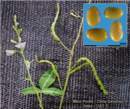Scientific name(s)
Desmodium uncinatum
Strengths
- Suited to subtropics
- Long growing season
- More drought tolerant than 'Greenleaf' desmodium
- Moderately shade tolerant
Limitations
- Poor persistence under heavy grazing
- Susceptible to amnemus weevil attack
- Needs fertile soils
- Weed potential in ungrazed areas
Plant description
Plant: A large trailing and scrambling perennial legume with a strong taproot.
Stems: The cylindrical or angular stems are covered with short, hooked hairs that stick to hair or clothing. Stems can root at the nodes if they touch moist soil.
Leaves: Comprise three hairy, pointed leaflets normally 7 - 8 cm long and 2.5 - 3 cm wide (up to 10 cm long x 5 cm wide), dark green in colour, with an irregular silver splash either side of the midrib on the upper surface, and lighter green and uniform in colour on the lower surface.
Flowers: pale lilac to pink in colour (bluish when mature), 0.8 - 1.0 cm long, borne in pairs along a long flowering stem.
Pods: Curved, 5 - 7 cm long, covered with short hooked hairs that stick to animals and clothing; breaking into 4 - 8 segments when mature.
Seeds: Roughly kidney-shaped and flat; mainly light brown in colour with mixture of olive-green to cream; 200,000-220,000/kg.
Pasture type and use
Grown in association with tussock and more open sward-forming grasses in permanent, semi-intensively managed pastures.
Where it grows
Rainfall
Best adapted to areas with average annual rainfall between about 1,000 and 1,600 mm, with warm season dominance. However, it can persist in areas with rainfall as low as 850 mm and as high as 2,400 mm. Late season rainfall is essential for successful seed-set.
Soils
Generally grows best on lighter and more friable soils of at least moderate fertility, but not on heavy clays. 'Silverleaf' is more tolerant of low pH, high Al and Mn than 'Greenleaf' but is intolerant of salinity.
Temperature
Peaks of growth occur in spring and autumn with a slight depression in the heat of mid-summer. It makes somewhat more rapid growth in early spring than 'Siratro' or the glycines. It will stand light frosts; heavy frosts will cut to ground level but not kill the crown.
Establishment
Companion species
Grasses: Green and Gatton panics, kikuyu, rhodes grass, setaria.
Sowing/planting rates as single species
Not sown as single species.
Sowing/planting rates in mixtures
2 - 3 kg/ha
Sowing time
Seedling development is slow, so sowing is best carried out when there is a high probability of follow-up moisture. In frosted areas, 'Silverleaf' should be sown in spring, once the probability of frost is low, to give as long a period as possible for establishment prior to onset of the next season's frosts.
Inoculation
Although seedlings may nodulate with native rhizobia, it is best to inoculate seed with special Desmodium inoculant to ensure the most effective nitrogen fixation.
Fertiliser
It requires at least moderate levels of fertility, and phosphorus, sulphur, and potassium may need to be applied.
Management
Maintenance fertliser
Soil fertility should be maintained with applications of about 200kg/ha superphosphate every 2 years, and muriate of potash as required, particularly if 'Silverleaf' is growing with "potash-hungry" setaria.
Grazing/cutting
Mature plants cannot tolerate constant heavy grazing or frequent heavy defoliation in which the growing points are removed; vigorous, dense stands can be reduced to a scattering of small individual plants. Grazing pressure should be adjusted to remove a proportion of leaf but retain growing points. Even under careful grazing management, 'Silverleaf' rarely persists for more than 5 or 6 years.
Seed production
'Silverleaf' commences flowering in mid-April, about a month earlier than 'Greenleaf'. Since seed matures about mid-June, seed crops should be grown in areas where there is a high probability of seed ripening before the onset of frost. Mechanical harvest is made difficult by uneven ripening of the seed and the sticky nature of the seed pods which can 'ball-up'. Crops can be direct headed yielding about 250 kg/ha of seed, or mowed when 50 percent of the seed is ripe, allowed to dry in a swath for 10 - 14 days before threshing, yielding about 330 kg/ha. Slow drum speed (200 rpm) reduces seed cracking.
Ability to spread
Pod segments adhere to animal coats and clothing. Trailing stems root at the nodes in moist soils. However, it will only spread into suitably fertile soils.
Weed potential
Often unflatteringly referred to as velcro vine, it has become a common weed in protected areas, particularly under shade and in the absence of grazing. While it can spread into forest margins trailing over shrubs, it does not twine up trees in the way glycine does.
Major pests
Plants, especially developing ones, can be weakened or killed by root-eating weevil larvae.
Major diseases
It is occasionally seriously affected by legume little-leaf disease.
Herbicide susceptibility
Moderate tolerance of 2,4-D.
Animal production
Feeding value
Nutritional value is fairly high. The relatively high tannin levels (± 3% of the dry matter) help to improve the efficiency of protein digestion ('by-pass' protein).
Palatability
Cattle graze the plant readily and intake is good, even after frosting. High tannin levels reduce palatability until stock acquire the taste for it.
Production potential
Legume yields of 4 - 7 t/ha and legume/grass yields of 15 t/ha DM.
Livestock disorders/toxicity
None recorded.
Cultivars
| Cultivar | Seed source/Information |
| Silverleaf | Australian Herbage Plant Cultivars |
Further information
Tropical Forages database (SoFT) - Silverleaf desmodium
Acknowledgements
-
Author and date
Bruce Cook
November 2008




